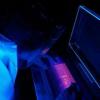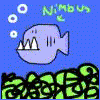
Odd mutations
#41

Posted 05 June 2007 - 12:36 PM
the characteristic will be passed on if it is dominant. if it is recessive then it will take more offspring to be born for the mutation to appear in the offspring, and the animals have to have the right breeding cross for the mutation to appear. if the allele for the mutation is recessive, then the animal must mate with another animal that is a homozygous recessive, or have at least 4 offspring if it mates with a Hetrozygous dominant animal, for the mutation to appear.
say this small mutation is in a male duck, and the mutation is , i dunno, maybe larger feet or something (helps it swim faster in the water) lets say the allele for the mutation is dominant. and he is a Hetrozygous male. his Genotype will be Ff (F= large feet (dominant), f= normal feet)
if this duck mates with a a female who is a homozygous recessive, her genotype will be ff.
this means that this will be the possible outcomes for the off spring;
Ff
Ff
ff
ff
that means that 1 out of every 2 of the offspring will have large feet. and they will be hetrozygous dominant. (Ff)
the other offspring will be normal ducks, with a homozygous ressevie alleles.

CnC Guild - As ancient as time itself.
Do you like anything CnC releated? Then the CnC guild likes you! Go make friends with it.
Latest Remix Escalation on ModDB
Remix Escalation on Revora - Track the latest news and changes.
#42

Posted 05 June 2007 - 02:09 PM
Phenotype is dependent on genotype, therefore this is not true. The genetic changes come first, and the phenotypical changes you observe in organisms are really the tangible effects of genetic changes.if there is a change in the organisms phenotype (what it looks like) that means there will also be a change in the Genotype.
This is a model that they teach in the fourth grade, mainly for its simplicity and, in light of any kind of scientific progress after 1830, incorrectness. It does not take into account any population shifts and for this to be true, the organisms would have to be in a perfect, sealed and controlled environment. Populations muck everything up which is, again, why I offered my explanation for the way genetic changes propagate.the characteristic will be passed on if it is dominant. if it is recessive then it will take more offspring to be born for the mutation to appear in the offspring, and the animals have to have the right breeding cross for the mutation to appear. if the allele for the mutation is recessive, then the animal must mate with another animal that is a homozygous recessive, or have at least 4 offspring if it mates with a Hetrozygous dominant animal, for the mutation to appear.
say this small mutation is in a male duck, and the mutation is , i dunno, maybe larger feet or something (helps it swim faster in the water) lets say the allele for the mutation is dominant. and he is a Hetrozygous male. his Genotype will be Ff (F= large feet (dominant), f= normal feet)
if this duck mates with a a female who is a homozygous recessive, her genotype will be ff.
this means that this will be the possible outcomes for the off spring;
Ff
Ff
ff
ff
that means that 1 out of every 2 of the offspring will have large feet. and they will be hetrozygous dominant. (Ff)
the other offspring will be normal ducks, with a homozygous ressevie alleles.
Additionally, this is certainly not a genetic thing. If it were genetic, and dominant, it would be a rather common thing in that population of ducks, if not the worldwide population of ducks, as they all share a relatively small gene pool since they were spread from their original location, and the amount of time for significant genetic drift to occur has not happened. Even though it is true that dominant alleles do not have to be the most prevalent, and that dominant alleles are commonly controlled by other alleles (all the introns of your genetic code are controlled by other genes which are transcribed first), this, if genetic, would still be rather prevalent due to its genetic nature.
Instead, it must be developmental. The reasons for this are rather compelling if you understand basic genetics and biochemistry.
1. No evolutionary history of six appendages. Ducks have two limbs and two modified limbs which serve as wings. For this to be genetic, it would have to have some basis in previous structural arrangement. Fully developed or even partially developed organs do not form out of nowhere, they have plenty of intermediaries to go through.
2. Developmental stage of the non-functional limbs. These limbs appear to be fetal, in order for them to be so, something must have occurred in the developmental stage to cause underdevelopment at the fetal level, or perhaps, these structures were created during the fetal stage. For it to be genetic, it would have to be the former, but even then, the structures would not be so advanced. Instead, it is likely that they would be little more than nubs, and that would be the extent of the genetic information contained in the genome. After five hundred generations, perhaps, if the mutation was favored, those nubs would become fully functional feet, but in this case, the structures are far too developed to be genetic. For them to form in the fetal stage, all you need are a few signal ligands and genetic promoters in the right places, and voila, two pairs will form from one pair, and one pair will be more favored than the other. Usually, this is the original pair which is favored, as with what happened in this case.
3. Hormonal nature of development. As explained above, the over presence of a hormone can cause differentiation of two pairs of structures instead of one. Since hormones essentially regulate development, this must be the case.
#43

Posted 05 June 2007 - 02:16 PM
#44

Posted 05 June 2007 - 02:52 PM
I'll read, reread, and rereread your response till I fully understand it. I have to do some research to better understand everything. And I just woke up.
But thank you for taking the time to write it out.
Save the environment, use green text
Some Bullshit Somewhere
#45

Posted 05 June 2007 - 03:35 PM
However, a change in phenotype will never precipitate a change in genotype. A change in genotype will sometimes cause a change in phenotype. Naturally, there are recessive genes which cause changes in only genotype and not phenotype, in fact, you carry around millions of genotypic "glitches," but you're no different for them. And naturally, anything that occurs post-fertilization is usually a developmental mutation, much like these cases on page one, however you can still have some genetic changes in the form of exposure to radiation. Additionally, a physical change, and not chemical change, occurs when the body regulates transcription of certain segments of DNA, causing some parts to be expressed or overexpressed, and some to be repressed. This, however, is a natural thing and is controlled wholly by the secretion of hormones and the formation of signal ligands.Genotype and fenotype are only partially related. A change in genotype does not necessarily change the fenotype, like for example with recessive mutations. Changes in fenotype can also occur without a difference in genotype, like for example through disease or other defect. Someone could have the genotype for a left arm and yet not be born with one.
However, the principle that I was attempting to elucidate remains true, that a change in phenotype will never facilitate a permanent change in genotype.
Truly my pleasure. It's nice to keep current in the field and always remain interested in the subject, especially during the summer breaks.But thank you for taking the time to write it out.
#46

Posted 13 June 2007 - 11:43 AM
Lurking moar since 2004 2003!
#47

Posted 13 June 2007 - 05:17 PM
Just want to clear something up before the question inevitably comes:]"Its because it's a genetic defect, the gene pool is actually concentrated in south west Wales, and so it's more likely to get a cat with that genetic defect, breeding with another cat with that genetic defect in Cardigan, than anywhere, else in Britain."
Polydactylism is a genetic thing.
Extra limbs is not a genetic thing.
The reason why this occurs is because of a genetic defect which really only becomes a problem during the differentiation of extremities. Control genes control the synthesis of developmental hormones for the extremities, and thus, something like this happens quite often (Especially in animals with small gene pools, such as domestic cats and frogs) when a gene pool is heavily concentrated and less common genes become much more common.
#48

Posted 13 June 2007 - 11:07 PM
This was always the thing I couldn't understand about evolution. Knowing this confirmed fact always made me wonder how animals evoled multiple limbs.Extra limbs is not a genetic thing.
I don't mean a hanging limb from a calfs head. I mean trully move from 2 limbs to 4 limbs. I still haven't taken the time to research Spensers other post. So I'll not make any more comments for now.
Save the environment, use green text
Some Bullshit Somewhere
#50

Posted 15 June 2007 - 10:30 PM
Also, the likeliness of it being a genetic defect is... marginal. Extra limbs are almost always developmental, caused by misappropriation of growth hormones. While yes, hormonal distribution is controlled by genetics, the chances of a genetic defect causing just extra limbs seems to be a bit low to me. Not likely, not impossible, but highly unlikely. Almost anything can cause a hormonal imbalance in an embryo, so most of the time it's developmental. Unless a significant mutagen is added to the embryo, it probably won't be genetic, and if it is, it will probably be accompanied by other problems.
Extra limbs = developmental.
Extra limbs + medical problems + things missing/things in the wrong place/gender ambiguity = possibly mutagenic.
While it could be solely genetic, it's very unlikely, more than likely developmental. This is not to say that a hormonal imbalance can't be caused by a genetic issue, but it's more than likely going to be something physical, perhaps environmental conditions or just a pain of random chance. The body isn't as precise as we'd like to think. We like to think that everything has a purpose, and that this purpose can't be maligned by other parts of the body (But about 500 immune system issues would disagree), however during development if the proteins or transcription factors are in the wrong place, things happen where they shouldn't. This is the basis of essentially all non-genetic birth defects.
#51

Posted 16 June 2007 - 10:29 PM
It is at this point that my intellect and understanding runs out. So for me the battle is over. I'll have to leave this one to the experts.
Save the environment, use green text
Some Bullshit Somewhere
#52

Posted 26 September 2007 - 07:13 PM
I don't know the reliability of this source AND its rather written in a sensationalist way, but if it were true I'm a bit worried.
Lurking moar since 2004 2003!
#53

Posted 19 November 2007 - 07:37 PM
So, theoretically, eventually, if given enough time, every species will eventually reach a point of perfection and stop evolving. Oh wait, that wouldn't happen because every time the predator perfects itself, the prey must compensate. I lied.
There could never be such a thing as a 'perfect organism' as perfection is subjective to the environment. If the environment changes then the scale of how well adapted the organism is changes. It could be argued a perfect organism(for the environment it is in) mantains a stable equilibrium of the population of its species. This is where the numbers of the species follow a wavy curve (up, down, up, down), as that kind of species will seem to mantain and not damage the enviroment it is in, by constantly growing, creating larger need for resources.
#55

Posted 20 November 2007 - 07:08 AM
This is fundamentally correct, but in a way, it can be simplified even further. Essentially, mutations and evolution are a consequence of having an environment and a genetic structure responsive to change. A perfect organism would maintain equilibrium and would never be affected by changing circumstances in the environment which would ultimately cause genetic shifts. This essentially means no selection pressures would be working on the organism, which, by the definition of, essentially, life, is impossible. All organisms are acted upon by selection pressures at all times, it's just sometimes they're not too significant and end up going nowhere. However, that said, even if they are minuscule, eventually genetic drift will take its toll and result in speciation.So, theoretically, eventually, if given enough time, every species will eventually reach a point of perfection and stop evolving. Oh wait, that wouldn't happen because every time the predator perfects itself, the prey must compensate. I lied.
There could never be such a thing as a 'perfect organism' as perfection is subjective to the environment. If the environment changes then the scale of how well adapted the organism is changes. It could be argued a perfect organism(for the environment it is in) mantains a stable equilibrium of the population of its species. This is where the numbers of the species follow a wavy curve (up, down, up, down), as that kind of species will seem to mantain and not damage the enviroment it is in, by constantly growing, creating larger need for resources.
Speciation, evolution, and genetic diversity are just natural consequences of having a gene pool and an environment with selection pressures.
There's no longer a question of if evolution occurs, or why it occurs in general terms; the big challenge is why it occurs in specific cases, what exactly happens in most cases we know of, and how we can quantify the modern synthesis of the theory in physical, ecological, genetic, and specific terms. Currently, there's no way to comprehensively model evolution effectively on any large scale in any sort of way. The best we can do at the moment is model microevolution (Pretty well) and small, isolated populations genetically (Hardy-Weinberg equilibrium and such). There are a few game theory based things which work well for small populations as well, even for competing species, but those tend to be scary...
It's a big thing these days. I think McGill offers an entire course on the mathematics of evolution for their evolutionary biology concentration (My program at the moment, so give it about two years and I'll be able to further elaborate on this in... laborious detail).
#57

Posted 20 November 2007 - 12:42 PM
#58

Posted 20 November 2007 - 11:37 PM
Francois Fagotto is an associate professor of biology at McGill whose speciality is in molecular biology, specifically in cell signalling, adhesion, and morphogenesis. His webpage is available at http://biology.mcgil...aculty/fagotto/ in case you're interested.I am by far not a specialist of evolution, so please take my comment with some caution!| From: Vicky Chang
| Subject: evolution question
| Date Sent: November 19, 2007 17:54
| To: Francesco Fagotto
|
|
| Hi Professor,
| This isn't really a class-related question, but I wanted to hear your opinion about it since I've heard you talk about evolution quite a bit in class. A book I'm currently reading talks about how mutations only bring about degeneration of genes/abilities (which is true when you think about how most of our genetic diseases are from mutations). It says that yes, natural selection happens nowadays, and it goes about with losing the unbenefitial genes (eg. a beetle lives in a very windy area and a mutation occurs that causes an offspring to not have wings--the wingless beetle would survive because it won't get blown away). However, with evolution, genes with completely new, and different functions need to be created (which, I'm assuming, would be done through mutations). How would that be possible, then, since all the known mutations to this day have caused degeneration? Are there any currently known mutations that have resulted in something completely new?
|
| Thanks for taking the time to respond,
| Vicky
I would stick to the simplest case point mutations, where only one amino acid is changed, or a stop codon introduced (but think that there is the whole issue about large scale changes such as chromosome rearrangements,...).
Looking at what influences the structure/function of proteins, it makes sense that the vast majority of point mutations will either be neutral (e.g. leucine replaced by valine in most cases has not effect on structure and function) or be deleterious. Only a small number of possible mutations will modify the function of a protein. This explains why evolution is very slow: to create a significantly new function one needs several consecutive mutations to accumulate, and the probability of the 'right' ones to occur is very low! Of course organisms that replicate fast evolve much faster, e.g. bacteria or viruses! As for us, imagine how much times it takes with a 20-30 years generation time!
However another way to modify an organism is not to change the coding sequence of a protein, but its expression (remember that mutations can occur anywhere in the genome). Mutations in the regulatory sequences can have very 'interesting' effects: an increase or decrease in a secreted growth factor, for instance, could modify the size and shape of a developing organ. A mutation could also easily create a new binding site for a transcription factor (activator, repressor), and that could lead to expression in a new organ, at a different stage, and so on...
There is for instance nice work that shows that modulation of a growth factor, BMP, plays a role in formation of the fingers/toes and can explain how you get a 'regular' foot of a chicken or the palmed foot of a duck. Similar observations show that during development very little change is required to produce feathers (birds) versus scales (reptiles), and in fact birds do produce scales (on the legs...).
Back to evolution of protein function, there is a very nice recent paper that published the functional analysis of protein intermediates that have been reconstituted from sequence comparisons, that should correspond to 'missing links' that existed at some point during evolution of vertebrates. The example is a hormone receptor that has evolved into two closely related receptors that have very different sensitivities to various sterol hormones. It shows in particular that some 'neutral' mutations become crucial to stabilize the structure upon a further mutation. In other words, the 'ground' must be prepared by modifications that have no direct influence on their own, but will be very important to allow in a next step a drastic change in part of the protein structure without having the protein distabilized/misfolded,...
The paper might be a little hard to read for students, but it shows nicely how molecular evolution probably works.
Here is the ref:
Ortlund, Bridgham, Redinbo, Thornton (2007)
Crystal Structure of an Ancient Protein: Evolution by Conformational Epistasis,
Science 317, 1544-1548
Regards
FF
Seems very pertinent. There's so much confusion over how evolution; at the least this can explain things on a level which I'm not remotely prepared to explain it, on the molecular level.
#59

Posted 01 December 2007 - 05:02 PM
#60

Posted 01 December 2007 - 05:39 PM
Exactly, a very good example of this is sickle cell anaemia.Another point is that beneficial and deleterious are context sensitive.
The sickle cell gene is co-dominant(i.e., both alleles have an effect).
An example:
RN = Normal red blood cell behaviour
RS = Sickle cell behaviour
With Heterozygous parents (eg, both RNRS) the following combinations are possible:

Now, RNRN offspring would have normal red blood cells.
RNRS would have some anaemic characteristics. (What we usually call sickle cell anaemia)
And RSRS would have full blown sickle cell anaemia.
Now we come onto why this is important.
Most sufferers of sickle cell anaemia are of African descent.
This is unusual as most genetic diseases are bred out of populations till they occur in very small amounts.
However, sickle cell anaemia has a benefit.
People with RNRS have some sickle cell characteristics to their bloodstream, which creates a very strong defence against the viruses in malaria, meaning a large benefit to 'sufferers' in malaria areas.
Boon or Curse?
In the West a curse, in some parts of Africa, a blessing in disguise.
(Hope I managed to explain this to a decent level of accuracy, if there is anything wrong, be sure to tell me.)
0 user(s) are reading this topic
0 members, 0 guests, 0 anonymous users























